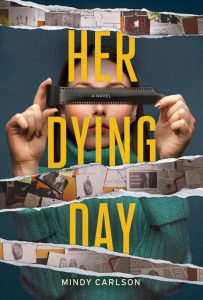Finding the Funny in Your Mysteries and Thrillers
Finding the Funny in Your Mysteries and Thrillers
 Humorous Thrillers. That sounds like an oxymoron. How can there be anything funny about murder, mayhem, and mystery? Yet, finding the comedy in crime has rocketed true crime to the top of the podcasting world. As of this month, three of the top ten podcasts are in the true crime genre and of the top five episodes this week, four are from true crime podcasts.
Humorous Thrillers. That sounds like an oxymoron. How can there be anything funny about murder, mayhem, and mystery? Yet, finding the comedy in crime has rocketed true crime to the top of the podcasting world. As of this month, three of the top ten podcasts are in the true crime genre and of the top five episodes this week, four are from true crime podcasts.
Comedy in mysteries isn’t a new concept recently uncovered by Millennials and Gen Z. Janet Evanovich has been the queen of the comedic mystery since she released One for the Money in 1999. Not to mention the cult classic Clue, released in 1985 and, in the age of the internet, the movie that spawned a thousand memes.
My own mystery writing heavily features humor. HER DYING DAY, my debut novel, is considered a cozy thriller because of the comedic voice coupled with the intense moments indicative of thrillers. The cozy thriller is for people who want the tension of a thriller, but still want what Agatha Christie called, “murders of quiet domestic interest.” Humor is one way of lightening the tension of the full-blown thriller into a mystery of domestic interest.
In an article in Scientific American, Giovanni Sabato writes that tension comes from a “juxtaposition of incompatible concepts … the incongruity between expectations and reality.” Writers in all genres rely on tension to captivate our readers. But the reader’s reaction tells us how that tension is released. In a thriller it could be a scream. However, many times that release of tension results in laughter, a theory posed by Sigmund Freund. There’s a reason why it’s called “comic relief.”
Murder and comedy. Two very incongruous concepts. But it means that mystery novels are ripe with opportunities for laugh-out-loud moments.
That relief allows writers to go more deeply into the dark places of their story because they are using the tool of humor as a pressure-relieving valve. The incongruous juxtapositions can be as easy as using a different word that expected, but one with a similar meaning.
Let’s say our hero, in the middle of being chased by our villain, gets a bright idea. We could write it as:
A light bulb switched on above my head.
Or we could write:
A chandelier switched on above my head.
The reader holds the expected image—a light bulb—in their head and when faced with the image of an ideal being so great it lights up an entire chandelier the tension is relieved in a subtle way.
It’s not just the release of tension that makes comedy work. It’s also authenticity. Comedic scenes are only funny when they come from a place of honesty about the human condition. Shoehorning jokes into a book won’t work. It’s inauthentic and artificial, and readers can spot a pre-fabricated joke for a mile away.
But what kind of comedy does work? Let’s look at the different categories of humor we have to work with. Psychologists tell us there are four kinds of humor. They are: facilitative, self-enhancing, aggressive, and self-depreciating humor. Facilitative humor is a funny story or a whacky scene in a book. No one’s being made fun of or mocked; it’s a release of tension. Self-enhancing humor is having a generally comedic outlook on life—your inner monologue is filled with witty bon mots. The other two are generally negative types of humor where you make fun of others or of yourself.
Self-enhancing and facilitative humor can translate as the voice of your book. I love a voicey book. Look at Dial A for Aunties, by Jesse Q. Sutanto. When I read Sutanto’s words I can hear Meddelin Chan, her intrepid heroine, speaking in my ear. A voicey book captures my attention and imagination. It draws me into the emotional journey of the hero just as strongly as if I were reading The Grapes of Wrath, which is one of the most humor-free books I’ve ever read. Even self-depreciating humor can be effectively used to take the reader into the low points of the hero’s journey—commonly called the dark night of the soul.
What’s important is authenticity in the comedy. Humor has to come from a place of honesty. The reader has to be able to identify with our main character or their situation and then be surprised by what happens because they themselves wouldn’t have thought of the character’s response. The tension relieved in an unexpected way.
The honesty should be the easy part. Our writing, even though it’s fiction, must come from a place of honesty and truth if we want the reader to sink into the world we’ve created. Taking that truth and adding the twist of the incongruous is what makes it funny.
That authenticity is what keeps a comedic thriller from coming across as smarmy and trite. Without authenticity our humor can read as overly aggressive. As authors we don’t want to appear mocking of our characters. Mocking others and using other forms of aggressive humor can damage our book’s emotional honesty.
Because at the end of the day we want our humorous mysteries to be emotionally honest stories about people our readers can identify with and love. One way to do that is through humor. After all, real life is hilarious.
—
BIO-
Mindy Carlson, M.S.O.D., grew up as an animal- and mystery-loving girl in Iowa before heading to California to see what she could make of her life. Now she lives in Maryland and is a successful parenting author, with pieces appearing in The Washington Post, Big Life Journal, and AFineParent.com. Her Dying Day is her debut novel. She blogs about parenting, cooking, and travel as the Swiss Family Carlson at http://www.MindyCarlson.com.
HER DYING DAY
PREORDER HERE
Category: Contemporary Women Writers, How To and Tips

 Perfect for fans of Shari Lapena and Hannah Mary McKinnon, a mystery writer’s sudden disappearance leads a budding filmmaker down a dark road to treachery, murder, and long-buried sins.
Perfect for fans of Shari Lapena and Hannah Mary McKinnon, a mystery writer’s sudden disappearance leads a budding filmmaker down a dark road to treachery, murder, and long-buried sins.





















